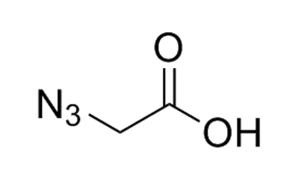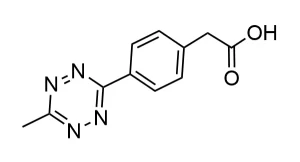Thiol-dPEG®12-acid, product number QBD-10850, is a single molecular weight, discrete-length polyethylene glycol (dPEG®) PEGylation reagent. One end of the medium-length (39 atoms, 46.8 Å) dPEG® linker terminates in a sulfhydryl (thiol) group, while a propionic acid moiety terminates the opposite end. The thiol end of the molecule forms dative bonds with gold, thioether bonds with maleimide and bromoacetate groups, and disulfide bonds with other sulfhydryl groups. The propionic acid group reacts with amines to form amide bonds. Alternatively, if it is left unreacted, the propionic acid group provides a negative charge to the conjugated molecule or modified surface.
Numerous scientific publications attest to the benefits of Thiol-dPEG®12-acid, including the following applications:
Assaying protease by using fluorescence quenching with gold nanoparticles;
Enhancing transfection efficiency;
Modulating glucose transport with gold nanoparticles;
Developing multiplexed bioassays on semiconductor gold nanocrystals;
Developing spectroscopy applications; and,
Detecting cancer through a FRET-based, NIR-activated system that uses gold nanoparticles.
| Unit Size | 100mg, 1000mg |
|---|---|
| Molecular Weight | 634.77; single compound |
| Chemical formula | C₂₇H₅₄O₁₄S |
| CAS | 1032347-93-5 |
| Purity | > 97% |
| Spacers | dPEG® Spacer is 39 atoms and 46.8 Å |
| Shipping | Ambient |
| Typical solubility properties (for additional information contact Customer Support) | Methylene chloride, Acetonitrile, DMAC, DMSO or water. |
| Storage and handling | -20°C; Always let come to room temperature before opening; be careful to limit exposure to moisture and restore under an inert atmosphere; stock solutions can be prepared with dry solvent and kept for several days (freeze when not in use). dPEG® pegylation compounds are generally hygroscopic and should be treated as such. This will be less noticeable with liquids, but the solids will become tacky and difficult to manipulate, if care is not taken to minimize air exposure. |
Greg T. Hermanson, Bioconjugate Techniques, 3rd Edition, Elsevier, Waltham, MA 02451, 2013, ISBN 978-0-12-382239-0; See Chapter 18, Discrete PEG Reagents, pp. 787-821, for a full overview of the dPEG® products.
Gold nanoparticle-based fluorescence quenching via metal coordination for assaying protease activity. Se Yeon Park, So Min Lee, Gae Baik, Kim and Young-Pil Kim. Gold Bull. 2012, 45 pp 213–219. October 25, 2012. DOI 10.1007/s13404-012-0070-9.
Systemically probing the bottom-up synthesis of AuPAMAM conjugates for enhanced transfection efficiency. Elizabeth R. Figueroa, Stephen Yan, Nicolette K. Chamberlain-Simon, Adam Y. Lin, Aaron E. Foster, and Rebekah A. Drezek. Journal of Nanobiotechnology. 2016, 14 (24). March 31, 2016. DOI: 10.1186/s12951-016-0178-9.
Modulating the Glucose Transport by Engineering Gold Nanoparticles. Sanjib Bhattacharyya, Krishna Kattel, and Franklin Kim. Journal of Nanomedicine and Biotherapeutic Discovery. 2016, 6 (1) pp 1-5. April 30, 2016. DOI: 10.4172/2155-983X.1000141.
Use of semiconductor nanocrystals to encode microbeads for multiplexed analysis of biological samples. Mikhail A Berestovoy, Regina S Bilan, Victor Krivenkov, Igor Nabiev, and Alyona Sukhanova. IOP Science. 2017, 784 (1) pp 1742-6596. March 15, 2017. DOI: 10.1088/1742-6596/784/1/012012.
Spectroscopy Based Approaches for Detection of Ions, Alpha-L-Fucosidase, and Singlet Oxygen. Eric Waidely. University of Miami Scholarly Repository. 2017, pp 1-113. May 3, 2017. http://scholarlyrepository.miami.edu/oa_dissertations/1842.
Near-Infrared-Activated Fluorescence Resonance Energy Transfer-Based Nanocomposite to Sense MMP2-Overexpressing Oral Cancer Cells. Yung-Chieh Chan, Ming-Hsien Chan, Chieh-Wei Chen, Ru-Shi Liu, Michael Hsiao, and Din Ping Tsai. ACS Omega. 2018,3 (2) pp. 1627-1634. February 8, 2018. DOI: 10.1021/acsomega.7b01494.
Signal enhancement of optical immunosensing by gold nanoparticles. Yuan Xintong. Nanyang Technological University, School of Material Science and Engineering Thesis for the degree of Master of Engineering. 2015, pp 1-74.
Biofunctionalized Polyelectrolyte Microcapsules Encoded with Fluorescent Semiconductor Nanocrystals for Highly Specific Targeting and Imaging of Cancer Cells. Galina Nifontova, Daria Kalenichenko, Maria Baryshnikova, Fernanda Ramos Gomes, Frauke Alves, Alexander Karaulov, Igor Nabiev, and Alyona Sukhanova. Advances on Applications of Optics and Photonics – Selected Papers from the 4th International Conference on Applications of Optics and Photonics, AOP2019. November 8, 2019. DOI: 10.3390/photonics6040117
NEW FRONTIERS FOR TRIPLE NEGATIVE BREAST CANCER DETECTION AND TREATMENT: FROM MECHANICAL BIOMARKERS TO SPECIFIC NANOPARTICLE ENTRY FOR ROBOTICALLY CONTROLLED LASER-INDUCED HYPERTHERMIA. Vanessa Uzonwanne. Worchester Polytechnic Institute. 2022. May 22, 2022.
SCORe: SARS-CoV-2 Omicron Variant RBD-Binding DNA Aptamer for Multiplexed Rapid Detection and Pseudovirus Neutralization. Lucy F. Yang, Nataly Kacherovsky, Joey Liang, Stephen J. Salipante, and Suzie H. Pun. Anal. Chem. 2022, 94, 37, 12683–12690. https://doi.org/10.1021/acs.analchem.2c01993
Applicable patents and legal notices are available at legal notices.




Stay in the Loop. Join Our Online Community
Products
Ordering
About Us
Application
Resources

©Vector Laboratories, Inc. 2025 All Rights Reserved.
To provide the best experiences, we use technologies like cookies to store and/or access device information. Consenting to these technologies will allow us to process data such as browsing behavior or unique IDs on this site. Not consenting or withdrawing consent, may adversely affect certain features and functions. Privacy Statement
How do I Request a Quote?
To request a quote for products: